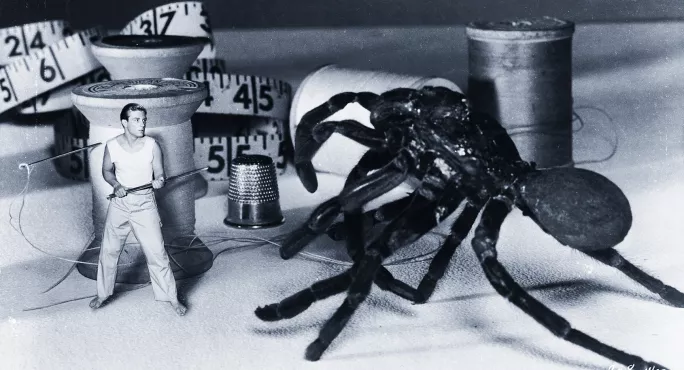How I open up the world of cinema in my school

From the very first moment I watched the hero fight off a giant spider with an oversized nail in 1957‘s The Incredible Shrinking Man, I fell in love with movies.
For many fans of cinema, this moment came the first time they witnessed a star destroyer firing its cannons at Princess Leia’s ship. I certainly remember sitting on a shaggy carpet, dropping crumbs as I gazed in awe at Star Wars playing out on the bulky TV in the corner of my living room.
I immediately had to know how these films achieved such wonderful magic. How did they make the cat in The Incredible Shrinking Man that size? How did they make the actor Grant Williams look so small? This was the beginning of my love story with cinema.
- Related: How should we teach film and cinema in schools?
- Interview: Mark Cousins on why cinema should feature in lessons more often
- Scare tactics: Horror films gaining popularity in English courses
- Podcast: What does cinema get right and wrong about school?
As I grew up, my taste in films evolved (some might say “matured”). I wanted to take in everything cinema had to offer, and would drag friends and family along to films they had never heard of, to try and ignite the same fire in them.
However, beyond the cinema itself, there was nowhere to indulge or feed this passion where I grew up. In school I was encouraged to take a different path because there were no careers in studying media.
The power of film studies
So I wanted to be the teacher who supported children like me: the person to ignite the fire in the bellies of students drawn to the big screen. I was going to give them a place to indulge in all things film, to flex their creative muscles and find their voice.
There were negative attitudes towards change, however, as well as a widespread lack of knowledge as to what exactly my subject is, not to mention the endless possibilities that come with it. My challenge was to change this perception and grow the profile of the subject throughout the school community.
Working with other departments throughout the school helped to raise the profile of media as a subject. Colleagues began to understand that it was not about watching and making films, but using film and filmmaking as a tool to unlock pupil potential. The growth of interdisciplinary learning, meanwhile, turned out to be a perfect vehicle for making links across the curriculum.
I created filmmaking awards for students at my school to celebrate the work that they achieved - work that is not acknowledged by the Scottish Qualifications Authority - and an awards ceremony that celebrates the students who are normally forgotten about. The students who are not sports stars or star academics but who are creative; the artists and the filmmakers. These are the unsung heroes we want to celebrate. The awards night is an excuse to get formally dressed and walk down the red carpet and celebrate the work of our talented students.
Teaching film and media has been the greatest pleasure of my life. If someone had told me years ago that one day I would be talking about film every day, not only as a hobby but as a career, I would have been overwhelmed with disbelief.
This is what I want to instill in children: the knowledge that there is a future and place for their love of film. I want them to believe that magic is not only in movies but also in real life. I understand how that cheesy sentiment could make people’s eyes roll, but it is true.
I never had the opportunities to study film at such intensity while at school - in fact, I was even discouraged from studying film after high school. This, then, has always been my mantra when teaching: if a student wants to learn about film, and to have a life working in film, who are we to stop them?
Fraser Johnston is a film and media teacher at St Mungo’s High School, in Falkirk. He tweets @MrJohnston85
Register with Tes and you can read two free articles every month plus you'll have access to our range of award-winning newsletters.
Keep reading with our special offer!
You’ve reached your limit of free articles this month.
- Unlimited access to all Tes magazine content
- Save your favourite articles and gift them to your colleagues
- Exclusive subscriber-only stories
- Over 200,000 archived articles
- Unlimited access to all Tes magazine content
- Save your favourite articles and gift them to your colleagues
- Exclusive subscriber-only stories
- Over 200,000 archived articles
topics in this article



